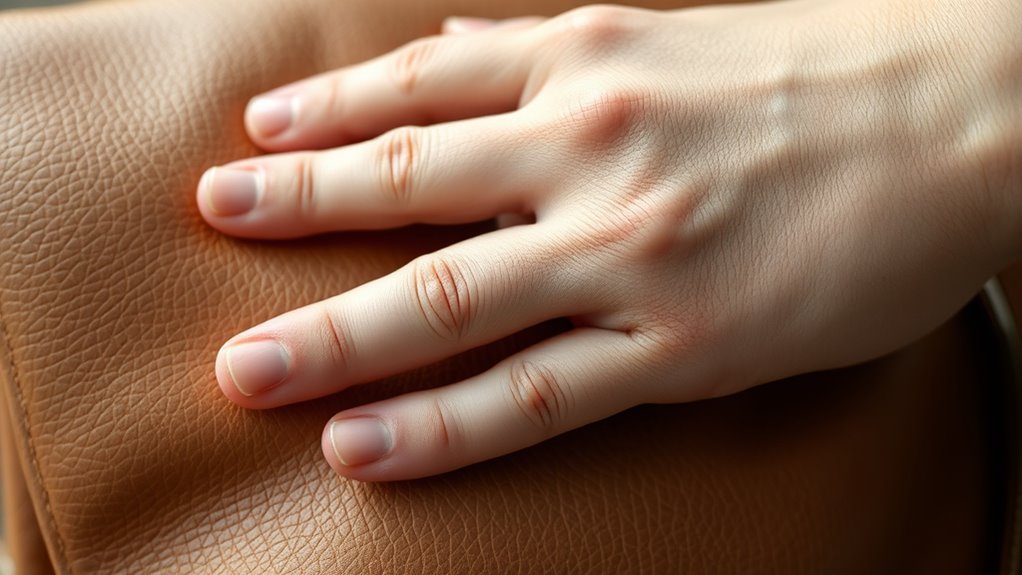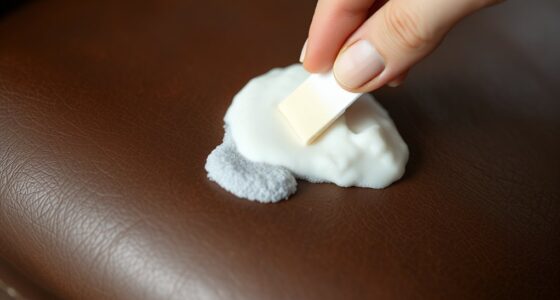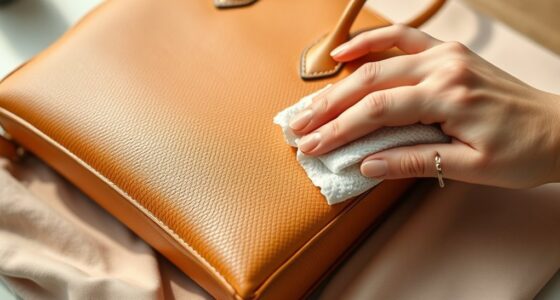To break in a new leather bag without cracking it, start by cleaning and conditioning the leather to keep it supple. Gradually introduce daily use, handling the bag gently and supporting it to avoid stress. Store it properly in a breathable dust bag away from sunlight. Applying soft heat with a warm cloth or using leather conditioners can help soften the material safely. For more tips on caring for your bag, continue exploring detailed techniques.
Key Takeaways
- Gently clean and condition the leather to keep it supple before use.
- Start with light, short-term usage and gradually increase to avoid stress.
- Handle the bag carefully, supporting it evenly to prevent creases or cracks.
- Use protective sprays and conditioners periodically to maintain flexibility.
- Properly store in a cool, dry place with a dust bag to preserve shape and prevent damage.
Understand the Leather’s Nature and Needs
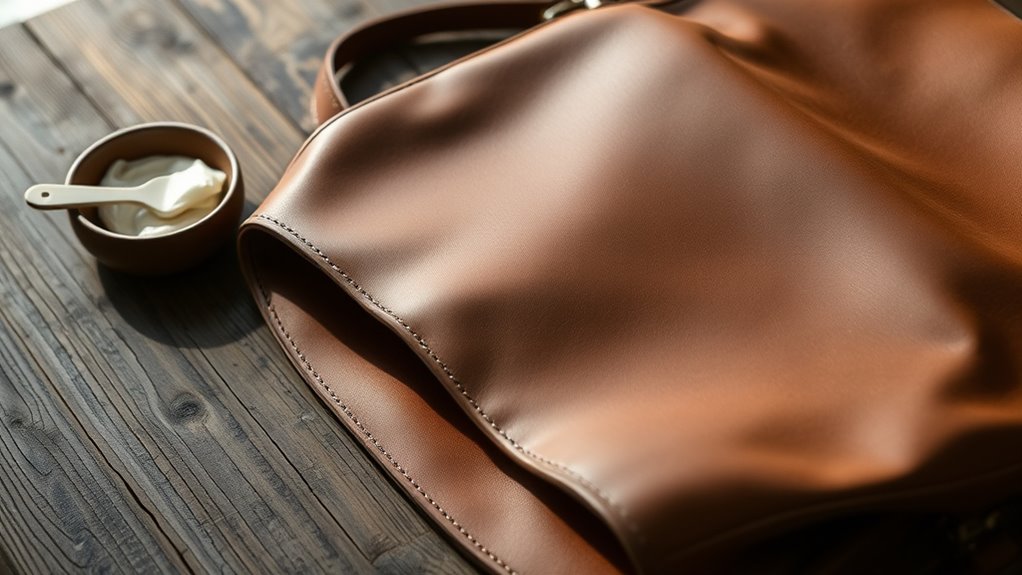
To effectively break in a leather bag, you first need to understand the leather’s unique characteristics and needs. The leather grain, which is the outermost layer, determines the texture and appearance of your bag. Full-grain leather, for example, retains the natural grain and is more durable, while corrected-grain leather has been sanded to remove imperfections. The tanning process also influences flexibility and strength; vegetable-tanned leather is stiffer initially but becomes softer over time, whereas chrome-tanned leather is softer right away. Knowing these aspects helps you handle your bag properly during the breaking-in process. By understanding the leather’s grain and tanning method, you can tailor your approach to conditioning and wear, ensuring your bag develops a beautiful, personalized patina without damage. Additionally, recognizing the type of leather can guide you in choosing the appropriate conditioning products and techniques for optimal results.
Clean and Condition Your Bag Before Breaking It In
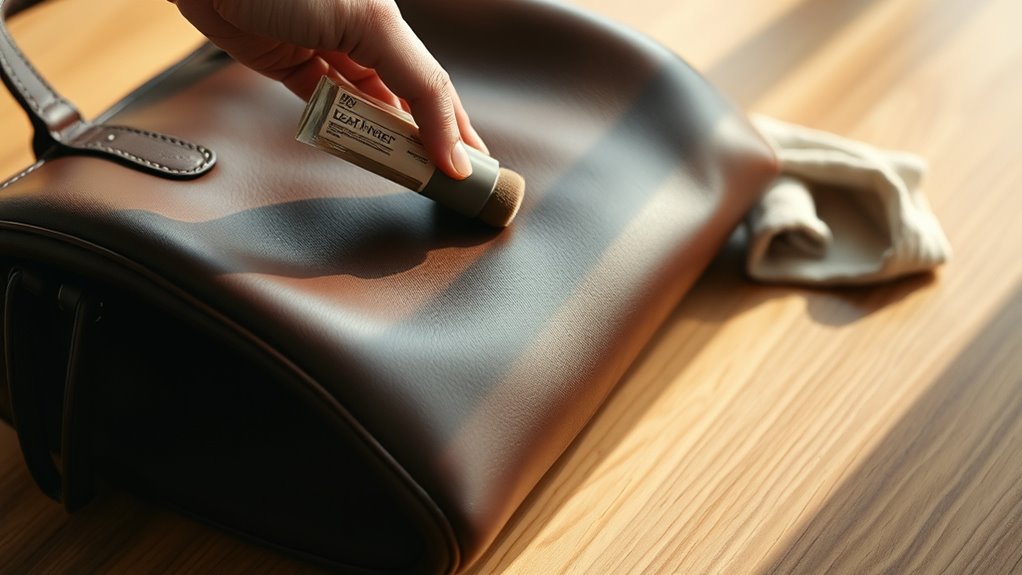
Before you start breaking in your leather bag, it’s important to give it a thorough cleaning and conditioning. Clean the surface gently with a soft cloth or leather cleaner to remove dust and dirt. This step helps prevent damage during the breaking-in process. Once clean, apply a quality leather conditioner to keep the leather supple and prevent cracking. If your bag has any leather dyeing, ensure it’s even and fully absorbed before use. Proper conditioning also helps maintain the leather’s natural flexibility. Additionally, check the hardware and perform hardware maintenance by tightening or cleaning metal parts to avoid scratches or tarnish. Taking these steps ensures your bag remains in top shape while breaking it in, making it more comfortable and durable over time. For optimal results, consider proper leather care to extend the lifespan of your bag.
Gradually Introduce Your Bag to Daily Use
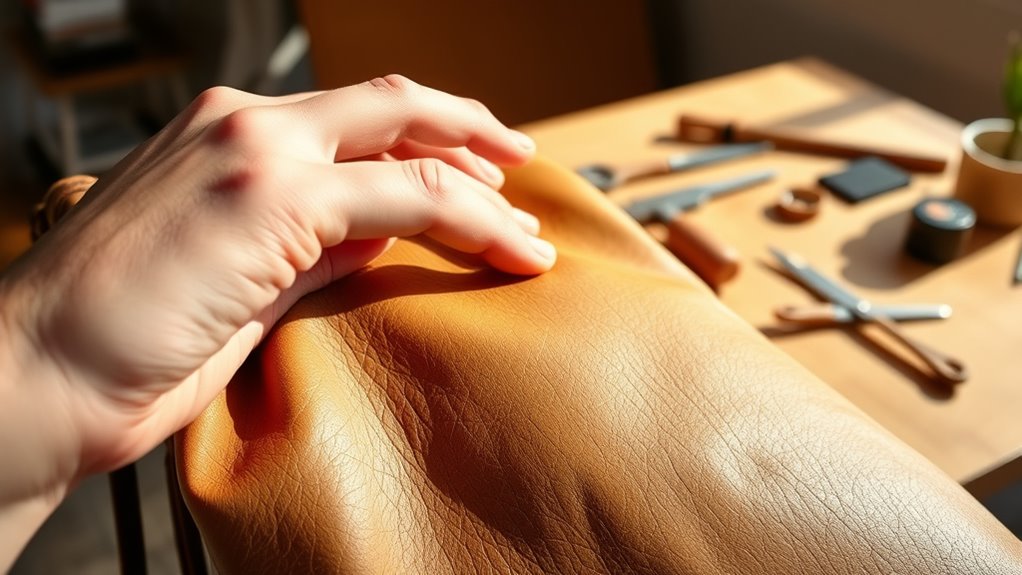
As you start breaking in your leather bag, it’s best to introduce it gradually to daily use. This allows the leather grain to adapt gently, preventing cracks or damage. The tanning process affects the leather’s flexibility; softer tanned leather responds better to gradual use. Begin by carrying the bag for short periods, avoiding heavy loads initially. Over time, increase usage to shape the leather naturally. To visualize:
| Usage Stage | Focus |
|---|---|
| Early Days | Light use, minimal weight |
| Intermediate | Moderate daily use |
| Full Use | Regular, long-term use |
This gradual process ensures your bag molds comfortably, while respecting its tanning process and preserving the integrity of the leather grain. Incorporating natural materials can also help the leather break in more evenly and beautifully over time.
Use Proper Storage Techniques When Not in Use

When you’re not using your leather bag, store it in a dust bag to protect it from dust and dirt. Keep it out of direct sunlight and away from high humidity to prevent damage and fading. Proper storage helps your bag stay beautiful and lasts longer. Additionally, consider using proper ventilation to prevent mold and mildew from developing inside the bag.
Store in Dust Bags
Storing your leather bag in a dust bag protects it from dust, dirt, and scratches that can cause damage over time. Proper leather storage is essential to maintaining your bag’s quality and appearance. Dust bag benefits include preventing exposure to airborne particles and accidental scuffs, which can weaken the leather. When not in use, place your bag inside a breathable dust bag to allow air circulation and avoid trapping moisture that could lead to mold or mildew. Make sure the dust bag is clean and fits your bag properly to prevent wrinkles or deformation. Using a dust bag also helps maintain the bag’s shape and keeps it looking new longer. Incorporating wicks into your storage routine by adding a small sachet of natural wax or oils can help keep the leather supple and moisturized. This simple storage step can extend your leather bag’s lifespan.
Keep Away From Sunlight
Keeping your leather bag away from direct sunlight is essential for preserving its color and texture. Sunlight exposure can cause the leather to fade and weaken over time, leading to cracks and irreversible damage. UV damage accelerates this deterioration, making your bag look aged and worn prematurely. When not in use, store your bag in a cool, shaded place, ideally inside a dust bag or a cloth cover that blocks out light. Avoid placing it near windows or in sunny spots where sunlight can reach it. Protecting your leather from UV rays helps maintain its natural beauty and flexibility, ensuring it stays supple and vibrant longer. Proper storage techniques also help prevent the leather from drying out and cracking. Proper storage not only prolongs your bag’s lifespan but also keeps it looking fresh and new longer.
Maintain Proper Humidity
Maintaining proper humidity levels is essential to preserving your leather bag’s condition over time. Proper humidity control prevents leather from drying out, cracking, or developing mold, which accelerates leather aging. When not in use, store your bag in an environment with consistent humidity—ideally around 40-50%. Avoid damp or overly dry areas, as fluctuations can damage the leather. To guarantee ideal conditions, follow these tips:
- Store your bag in a breathable dust bag or cloth cover to promote airflow.
- Keep it in a cool, dry place away from direct heat sources and humidity spikes.
- Use silica gel packs or humidity control packs inside storage to regulate moisture levels.
- Regularly inspect your stored bag to ensure the environment remains stable and free from excess moisture control humidity.
Employ Gentle Heat to Soften the Leather Safely
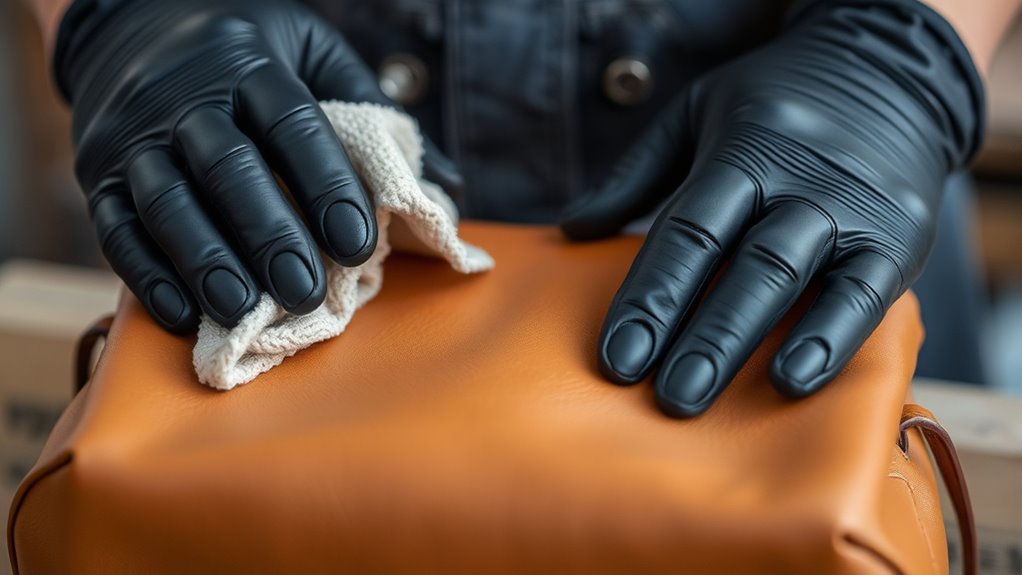
To soften leather safely, employing gentle heat is an effective method, but it’s essential to be cautious. Slow, controlled heat application helps increase leather flexibility without risking damage. Use a hairdryer set to low or warm, keeping it at a safe distance from the surface to prevent overheating. Move the heat evenly across the bag’s surface, focusing on areas that need more pliability. Keep the heat for short bursts, checking regularly to avoid drying out or cracking the leather. This method gently loosens the fibers, making the leather more supple and easier to shape. Remember, patience is key—overheating can harm the leather, so always use a low setting and monitor the process carefully.
Use Softening Agents and Leather Conditioners
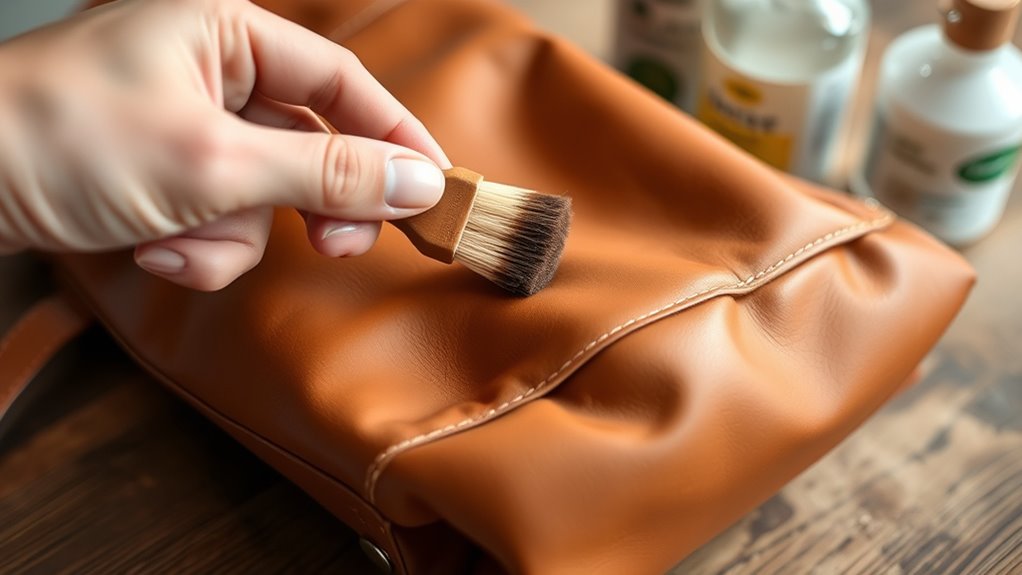
Using softening agents and leather conditioners is one of the most effective ways to make your leather bag more flexible. These products penetrate the leather grain, helping to relax the fibers without damaging the tanning process. Proper conditioning prevents cracking and keeps the leather supple as it breaks in. Additionally, selecting conditioners that support leather preservation ensures the longevity and durability of your bag over time.
To use them effectively:
- Apply a small amount evenly across the surface, focusing on areas that feel stiff.
- Let the conditioner sit for a few minutes to absorb into the leather.
- Buff gently with a soft cloth to remove excess product and enhance the leather’s natural shine.
Choose conditioners suited for your bag’s leather type, and avoid harsh chemicals that could damage the leather grain or interfere with the tanning process.
Practice Careful Handling During Break-In

When breaking in your leather bag, handle it gently from the start to prevent unnecessary stress. Avoid excessive bending or twisting, which can damage the material over time. Using protective products can also help maintain its shape and durability during this delicate process. Additionally, understanding city dynamics can help you better care for your belongings in a new environment, ensuring your leather bag remains in excellent condition as you settle in.
Handle Gently at First
Since leather is still soft and malleable during the initial break-in period, handling your bag gently helps conserve its shape and prevents unnecessary wear. Being careful with the leather texture ensures the handle remains flexible without cracking.
To do this effectively, consider these tips:
- Avoid forcing the handle into tight spaces, which can stress the leather.
- Use both hands to support the bag, distributing pressure evenly.
- Store the bag in a soft dust bag when not in use to maintain handle flexibility.
Handling your leather bag with care during this period allows the leather to adapt naturally, reducing the risk of cracking. Gentle treatment preserves the bag’s appearance and extends its lifespan, making sure it ages gracefully.
Avoid Excessive Bending
While breaking in your leather bag, it’s important to avoid excessive bending, as it can cause permanent creases and weaken the material. Repeated or sharp bending stresses the leather, leading to unwanted leather stretching or leather cracking over time. To prevent this, handle your bag gently and avoid folding or twisting it unnecessarily. Use both hands to support the structure when moving it around, and don’t force it into tight spaces. Consistent, gentle handling helps the leather mold naturally without overstressing it. Remember, the goal is to soften the leather gradually, not to cause strain. Incorporating AI-powered tools can assist in understanding proper leather care techniques and maintaining your bag’s quality. By practicing careful handling and avoiding excessive bending, you preserve the leather’s integrity and ensure your bag breaks in beautifully without cracks or permanent creases.
Use Protective Products
Applying protective products to your leather bag helps safeguard it during the break-in process. Using leather care products like protective sprays creates a barrier that shields your bag from stains, scratches, and moisture. This step is essential to maintain its quality while softening the leather gradually.
To guarantee proper use, consider these tips:
- Spray a light, even coat of protective spray on all surfaces, avoiding excess.
- Allow the spray to dry completely before handling or filling the bag.
- Reapply the protective layer periodically, especially if you notice signs of wear or exposure to elements.
Maintain and Preserve Your Leather Bag Over Time
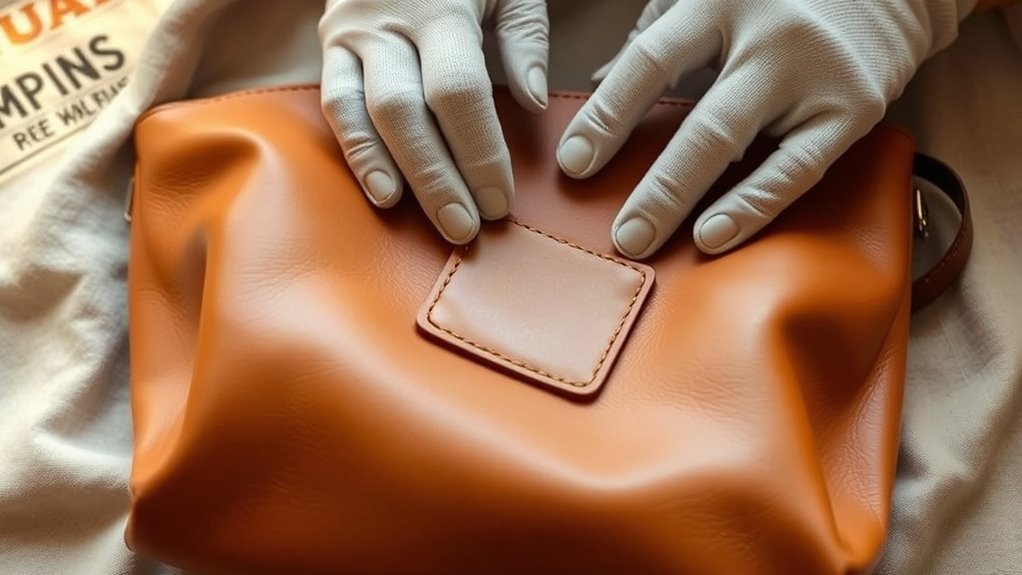
To keep your leather bag looking its best over time, regular maintenance is essential. Proper leather care involves cleaning it gently with a damp cloth and applying a quality leather conditioner to prevent drying and cracking. Store your bag in a dust bag or a cool, dry place away from direct sunlight to avoid fading and damage. Avoid overstuffing your bag, which can distort its shape, and handle it with clean hands to prevent oils and dirt from transferring. Regularly inspecting your bag allows you to catch and address small issues early. Bag preservation relies on consistent care, so make it a habit to clean, condition, and store your leather bag properly. This way, you’ll ensure it ages beautifully and maintains its value over time.
Frequently Asked Questions
How Long Does It Typically Take to Break in a New Leather Bag?
Breaking in a new leather bag usually takes a few weeks, depending on usage. You should regularly apply leather conditioning to keep it supple and prevent cracking. Also, store your bag properly when not in use, using bag storage techniques to maintain its shape. With consistent care, your leather bag will soften naturally and develop a unique patina, making it more comfortable and stylish over time.
Can I Use Household Items to Soften My Leather Bag?
Think of your leather bag as a shy flower waiting to bloom. Household remedies like applying a small amount of conditioner or rubbing a bit of coconut oil can work wonders for leather softening. Gently massage these natural solutions into the leather, helping it become more supple without risking cracks. Just remember, patience is key; use these household items carefully to nurture your bag into a more flexible, beautiful state.
Is It Safe to Expose My Bag to Sunlight During the Break-In Process?
You might wonder if sunlight exposure during break-in is safe. While a little sunlight can help soften leather, too much can cause leather fading and damage. Prolonged exposure weakens the material and leads to cracks or discoloration. To avoid this, keep your bag out of direct sunlight, especially during the early stages. Use natural methods like conditioning and gentle stretching instead, ensuring your leather stays durable and looks great.
How Often Should I Condition My Leather Bag for Optimal Flexibility?
You should condition your leather bag every 3 to 6 months to maintain ideal flexibility. Regular leather conditioning helps keep the material supple and prevents cracking over time. If you notice your bag becoming stiff, it’s a good sign to apply a quality leather conditioner. Consistent care ensures your bag stays soft, flexible, and durable, so you can enjoy it for years to come.
What Signs Indicate My Leather Bag Is Cracking or Damaged?
You’ll notice signs of cracking or damage when your leather bag’s surface starts to develop fine lines or appears dry and brittle, indicating aging and potential cracking. To prevent this, keep an eye out for uneven texture or discoloration, which can signal deterioration. Regular conditioning helps with cracking prevention, maintaining flexibility and luster. If you see significant cracks or peeling, it’s time to treat or consider professional repair to preserve your bag’s longevity.
Conclusion
Through patience and gentle care, your leather bag will evolve, softening like a sunrise awakening the sky’s first hues. As you nurture it with love and attention, it’ll become a trusted companion, molded perfectly to your style and needs. Think of the journey as a quiet dance—each step, each touch, shaping a timeless piece that ages gracefully with you. With understanding and gentle hands, your bag’s true character will shine, revealing its beauty over time.
